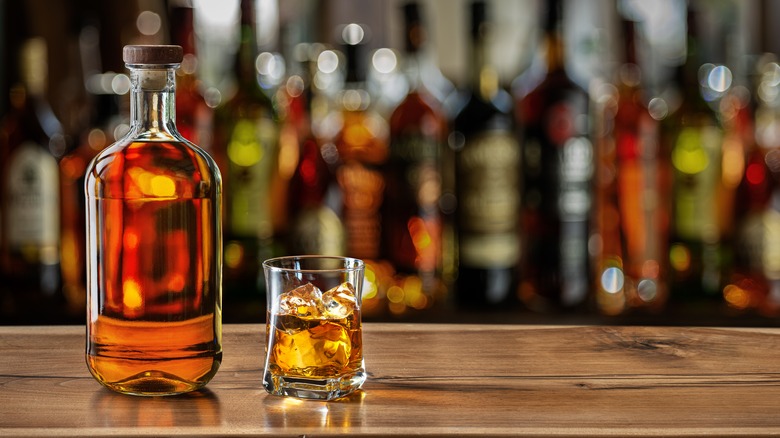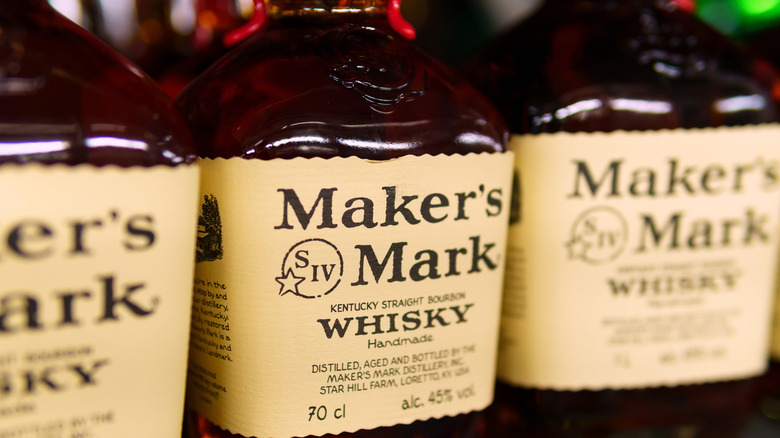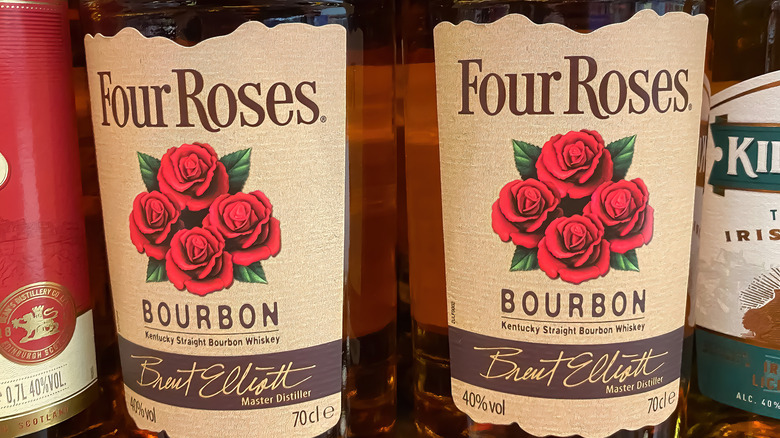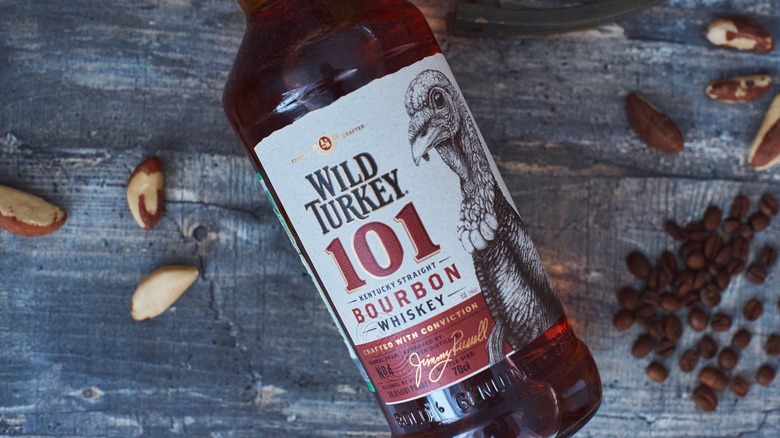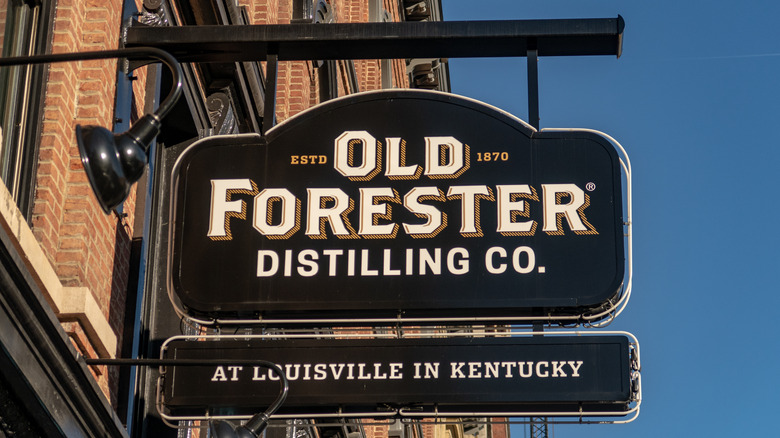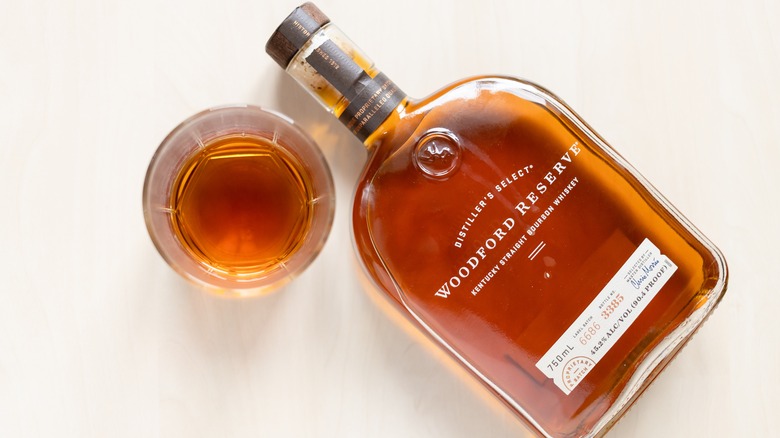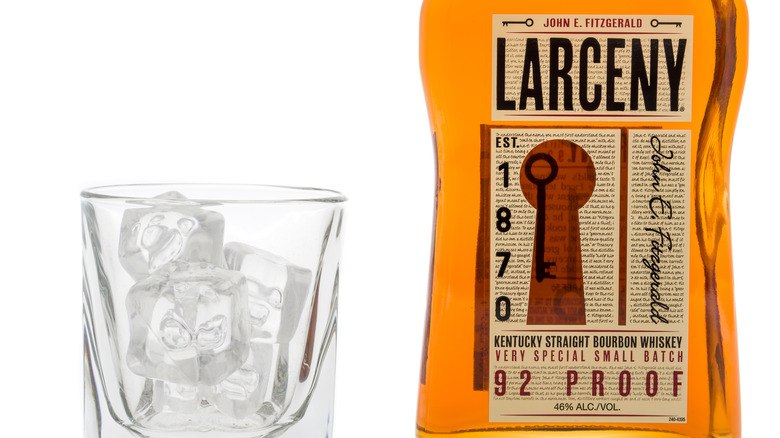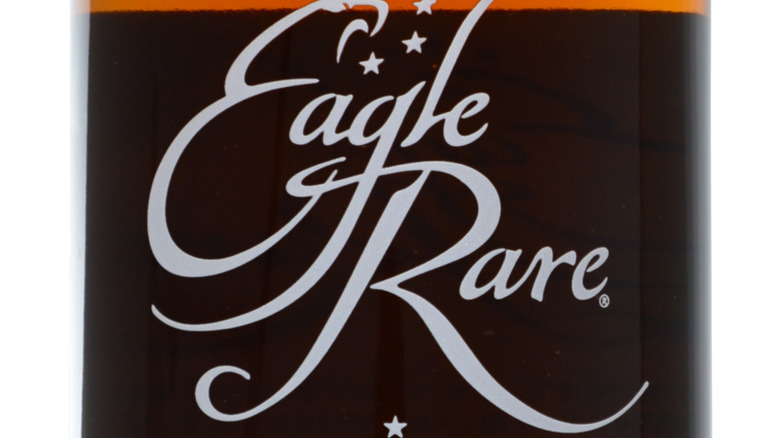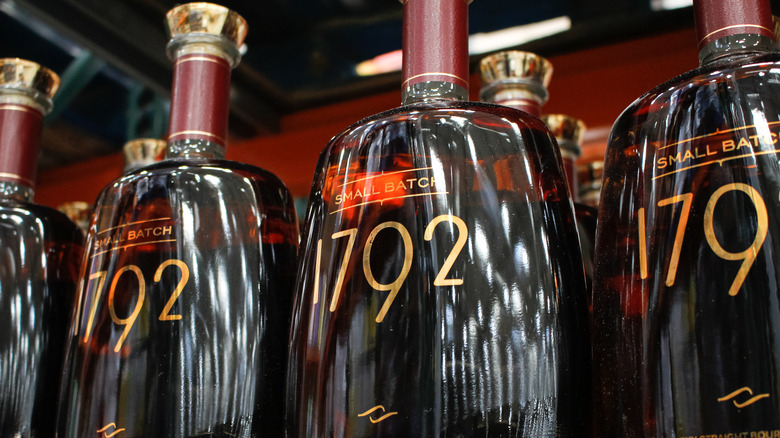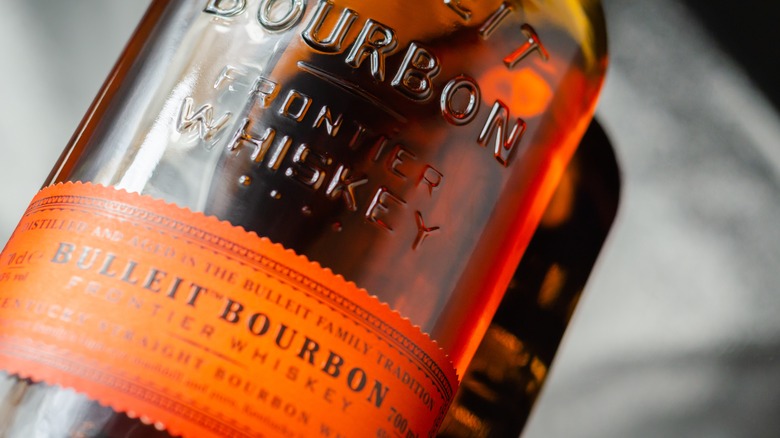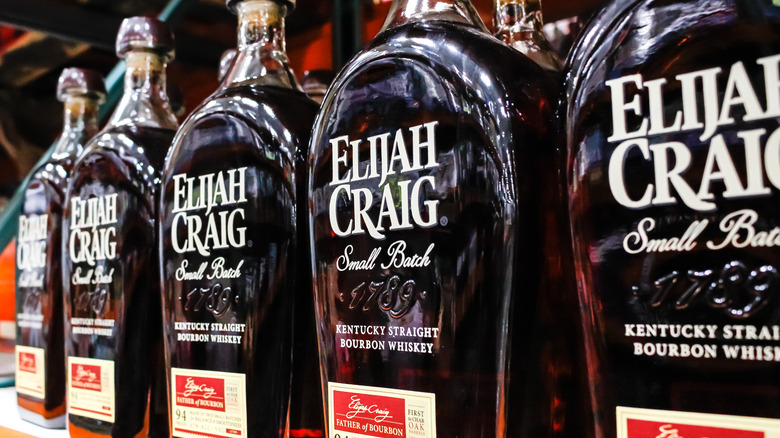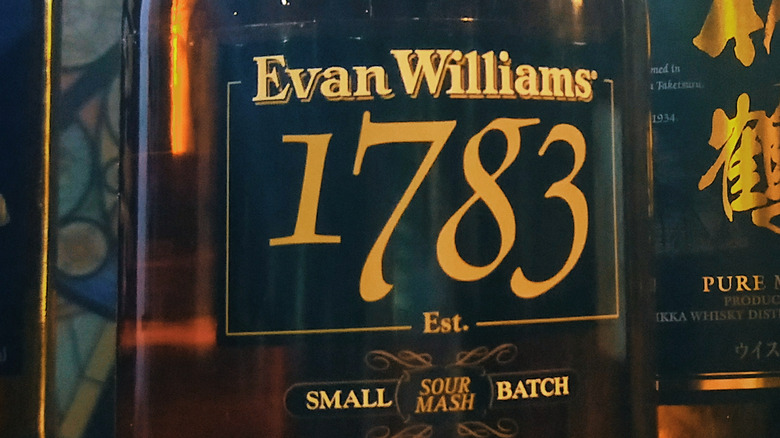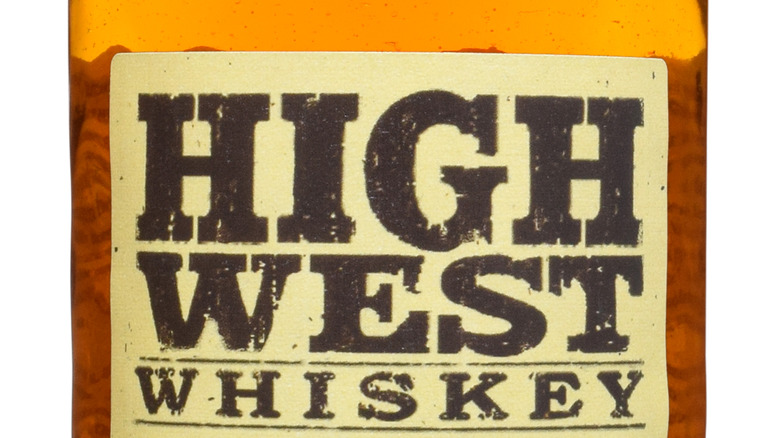A Beginner's Guide To The Best Bourbons To Buy
The world of whiskey is so vast and complex it can be overwhelming, but if you're looking to dip your toe in the pool, bourbon is a great place to start. It's a quintessentially American spirit: In fact, in order to be called bourbon, it must be made in the United States — not just Kentucky, as many assume. It's easy to love, thanks to its bold, sweet, and spicy character.
Here are a few basic terms to get to know on your way to becoming a bourbon connoisseur. All whiskey starts with what's called a mash, which consists of the grains that are going to be fermented, water, and yeast. The mash bill refers to the types of grains that are used — for bourbon, the mash bill must consist of at least 51% corn, with some combination of wheat, rye, and barley typically filling out the rest. Once the mash is fermented, it's known as wash or beer, which is then distilled and aged. For bourbon, this requires a minimum of two years in charred new oak barrels, but many are aged much longer. The whiskey is then bottled, either unchanged at cask strength or diluted with water to the desired proof. No other ingredients are allowed.
There are many styles of bourbon, and the best way to find your favorite is to explore them all. We've put together a selection of some of the best bottles to get you started on your journey.
Maker's Mark
The Maker's Mark recipe was created to be smooth and easy drinking, which makes it the ideal bourbon for beginners. Its distinctive flavor comes from red winter wheat, which makes up 16% of the mash bill along with 70% corn and the rest malted barley (noticeably, rye is absent, which contributes to the overall sweet character of this bourbon). Maker's Mark is made using the sour mash technique, which means yeast is taken from a previous batch and added to the current batch, passing down through the generations. You may be familiar with this if you make sourdough bread — it's the same process. This creates a more consistent flavor than using a new yeast strain each time.
This bourbon is soft and round on the palate, with pleasantly sweet notes of caramel and vanilla and a fruitiness reminiscent of candy apples. It's rich, but still seems light on its feet, which makes it dangerously easy to sip, and the alcohol is well-integrated so it doesn't attack your nose or palate in any way. Maker's Mark is versatile, as delicious in classic cocktails as it is on its own. It's also priced affordably, and the iconic hand-dipped red wax cap makes it an aesthetically pleasing addition to any home bar.
Knob Creek Small Batch
Knob Creek's Small Batch bourbon is bold and assertive, and at 100 proof it packs a lot of punch. That intensity, along with nine years of aging in white oak, gives this bourbon a lot of depth and flavor. Along with the signature vanilla and caramel notes you'll find in every bourbon, it's got a distinctive spiciness that comes from the rye that makes up 13% of the mash bill (the rest is 77% corn, 10% malted barley).
For bourbon beginners looking for a robust, spicy spirit, Knob Creek Small Batch is a good choice to start with. Its alcohol isn't overpowering so you can sip it neat or on the rocks, but the high proof and concentrated flavor lend it well to cocktails, too, as it holds up to dilution. Knob Creek Small Batch makes a fabulous classic Bourbon Manhattan, as vermouth brings out its fruity sweetness and the bitters punch up its spice.
Four Roses
Four Roses bourbon is one of the best values in the category. For an extremely affordable price, you get a very smooth, well-balanced, and drinkable bourbon that's easy to mix and sip. It's proofed low, at 40% ABV, which is technically the lowest alcohol level bourbon can have and still call itself bourbon. This gives it a light body and more delicate mouthfeel than many of the other more robust bourbons on this list, making it a good choice for beginners who might want to start with a milder spirit.
Four Roses' production process is incredibly complex. They create ten different base whiskeys using two mash bills and five proprietary yeast strains, then blend those together to create their various bottlings. Both of their mash bills are rye-heavy — 20 and 35% of each mix — which gives their bourbons a bright spicy character. It makes easy-drinking cocktails thanks to its low proof — try it in a refreshing Mint Julep.
Buffalo Trace
The Buffalo Trace distillery crafts some of the world's best-loved whiskeys, and they keep the specific recipes close to their chest. The mash bill for Buffalo Trace's straight bourbon is presumed to be corn with 10% rye and 15% barley, and it's aged at least eight years, although there is no official age statement on the bottle. At 90 proof, it's mellow enough to sip but strong enough to have a sturdy presence in cocktails, making it an excellent bottle for bourbon newbies.
The rye in the mix makes itself known with aromas of warm spice, which give way to classic sweet vanilla and brown sugar flavors. There's a little bit of pepper and another pop of spice and a hint of fresh mint on the finish that keep the sweetness from taking over your palate. This complexity makes Buffalo Trace a rewarding bourbon to enjoy neat or on the rocks. For the quality you get, it's a nice value.
Wild Turkey 101
Wild Turkey 101 is not for the faint of heart, but if you're looking for a potent, powerful bourbon to kick off your exploration of the spirit, it's a fantastic choice. Its recipe has remained unchanged for over half a century, giving it a timeless, classic character — a fairly high rye content at 13% gives it a spicy edge. Like all Wild Turkey products, it's aged in barrels that have the maximum amount of char, which intensifies the flavors even further and adds a toasty, smoky quality. It sees at least six years of age in these barrels and develops a strong oak character.
It may be a little too punchy to enjoy on its own, especially for bourbon initiates, but Wild Turkey's 101 proof makes it a perfect fit for cocktails. This bourbon's intensity lends it well to drinks with other strong flavors, like a Smoked Old Fashioned. It's also a phenomenal value.
Old Forester Signature 100 Proof
Old Forester's Signature 100 Proof bourbon is high proof and high rye — 18% — which puts it on the more intense side of the spectrum. Its best characteristic is its richness, in flavor and aroma as well as body. It's not a shy bourbon by any means, and will definitely make its presence known in a cocktail. It's reasonably priced, especially for a 100-proof spirit, making it a good value and a fine high-intensity bourbon to experiment with.
The Old Forester Distillery is the only whiskey company operating today that survived Prohibition in the United States by switching its production to industrial alcohol. Their bourbons may not be cutting-edge, but they are certainly classic, and their history makes them even more interesting. Old Forester also makes an 86-proof bourbon which is another good bottle for beginners, but the 100-proof's robustness and intensity make it the more exciting choice. A versatile cocktail bourbon, it's got a slightly bitter finish that can be punched up with other bitter ingredients, or mitigated when mixed into sweeter drinks.
Woodford Reserve
Nuanced, smooth, silky, and complex, Woodford Reserve is one of the more sophisticated bourbons you'll find. It's on the higher end of this list when it comes to price, but for the quality, you're getting a lot for your money. There's a high percentage of rye here — 18% – but its spiciness is subtle, adding dimension to the toasty, sweet flavors that dominate its profile. The most notable characteristic of Woodford Reserve bourbon is its texture — it coats your palate with a rich creaminess that many other bourbons in this price range lack. That makes it an incredibly satisfying whiskey to sip on, and since its flavors are well-balanced, it can be easily enjoyed by any beginner.
It's good in a cocktail, too, although at its price point, you may be hesitant to do too much experimentation. You don't want to bury its subtle charm with too many other flavors, but it really shines in spirit-forward, classic drinks that showcase its richness and supple texture. It makes an exceptional Boulevardier.
Larceny Small Batch
Larceny is a fairly new addition to the bourbon game, having been introduced in 2012, although its recipe is inspired by classic Old Fitzgerald brand whiskeys. It's known as a wheated bourbon, which as you might suspect means that its mash bill is heavy on the wheat. Larceny contains more wheat than other wheated bourbons, with the grain making up 20% (as opposed to Maker's Mark which clocks in at 16%). A strong wheat component translates to a smooth round texture and sweet bready flavors like cereal and brioche, making this an appealingly mellow bourbon that's perfect for beginners seeking an easy-going experience.
Try Larceny side-by-side with a rye-heavy bourbon and you can really tell what a difference the mash bill makes — this is a great exercise to discover what flavors you prefer. Larceny's affable sweetness matches up nicely with honey, making it a great choice for a Classic Hot Toddy. It also makes a fantastically smooth sipper.
Eagle Rare
When you're ready to step into the world of longer-aged bourbons, Eagle Rare 10 Year is a great starting point. Unfortunately like with many aged bourbons these days, supply issues have wreaked havoc on the market as demand has skyrocketed, and it can sometimes be hard to find this bottle at a decent price. But if you're lucky enough to get your hands on some from a reputable vendor close to when it's annually released, it's a worthwhile bottle to enjoy.
As bourbon ages in a barrel and the water evaporates, leaving behind more concentrated flavors and a richer texture. Eagle Rare shows this off nicely with a complex honeyed, chocolatey character that's balanced by herbal and spicy notes. Influence from the wood barrels is notable as well, with lots of nuttiness and toasty oak flavors. The fruit quality is indicative of its age, too, with notes of baked apples and stewed figs. This intriguing tapestry of complex flavors and aromas is best enjoyed neat, with a dash of water to bring out its perfume.
1792 Small Batch
1792 Small Batch is a fantastic all-around beginner bourbon that exhibits bold flavor and versatility. It may not be as smooth or as easy to drink as some of the other options on this list, but it makes up for that with a unique, intense flavor that's unmistakable. It has a high rye content, and although the exact percentages aren't advertised, it's estimated to be about 15 to 25% of the total. The influence of that rye is obvious in the spicy aromas and flavors that leap out of the glass, followed by the more traditional caramel and vanilla notes.
If you're new to tasting spirits and have trouble picking out subtle flavors, this is a good bourbon to train your palate with — even the least experienced taster should have no trouble identifying the intense, straightforward scents and tastes on display here. To taste like a professional, it's helpful to use a proper glass — the ideal vessel for whiskey is called a Glencairn, a short glass with a tulip-shaped body. You want to note the color and the aromas first, and then tackle the flavors. Holding the bourbon in your mouth will let it better penetrate your palate, and eventually, you want to develop a technique called the Kentucky chew, in which you swish the bourbon around in your mouth to let the hot alcohol sensation dissipate so you can appreciate the more complex flavors.
Bulleitt
Made with a hefty dose of rye — 28% — and only 4% malted barley, Bulleit is a full-flavored bourbon with a spicy kick that finishes smooth. It's bottled at a balanced 90-proof, making it a versatile whiskey for both sipping and cocktailing. It's a great introduction to rye-driven bourbons for burgeoning aficionados, giving you that signature robust rye flavor without the harshness that sometimes comes along with it.
While its flavor doesn't come across as particularly rustic, Bulleit is based on a 150-year-old bourbon recipe, and the brand really leans into the old-fashioned character with its packaging. It's labeled as Frontier Whiskey, and the bottle looks like it would be right at home in an Old West saloon. The spirit inside, though, has a more refined and modern feel, especially when enjoyed neat or over a few rocks. As mentioned, it's also great in cocktails. Try it in this Bulleit Cold Brew Old Fashioned and give yourself a boozy buzz.
Elijah Craig Small Batch
As a beginner bourbon drinker, you can't go wrong with Elijah Craig Small Batch. This excellent whiskey shows as much balance and versatility as any bourbon at this price point, making it a good bargain. This is a corn and barley-heavy bourbon, with only 10% rye content. There is a touch of spice, but the major aroma and flavor characteristics are on the sweeter side — vanilla, caramel, rich fruit, honey, and nuts. A hint of smoke from the barrel is there too, along with some bright herbal notes on the nose. While the sweet flavors dominate, it still manages to feel balanced on the palate.
Elijah Craig is a real beauty when it comes to cocktails. At 94-proof, it's got a little more juice than your 80 or 90-proof bourbons, but it's smoother and mellower than your 100-proof whiskies. This puts it right in the sweet spot for mixing. It stays flavorful in just about any style of cocktail, from a wine-laden New York Sour to a classic Manhattan.
Evan Williams 1783 Small Batch
In 2021, Evan Williams revamped their 1783 whiskey, giving it a more elegant package and, most importantly, amping up the proof. Now at 90 proof with a minimum of six years of age, it's one of the best values on the market and a great option for bourbon beginners. While it won't blow your mind, it's a smooth and easy-drinking bourbon. Its mash bill is identical to Elijah Craig Small Batch (both whiskeys are made at Heaven Hill Distillery, and share a base spirit), heavy on the corn and light on the rye, with barley making up the rest.
Evan Williams 1783 is sweet and nutty, with a little fruit and spice, and shows decent depth thanks to its age. It's a pleasant, if not thrilling, bourbon to sip on its own, and it makes a solid, smooth cocktail, especially now that it's been proofed up. This bottle is a great example of the lower-rye, sweeter style, and the price is right for cocktail experimentation and generous pours.
High West
High West bourbon was formerly called American Prairie bourbon, and although the name has changed, the whiskey in the bottle is still the same. The High West distillery was started in 2006 in Utah, the first to operate in the state in over a century. While they distill their own spirits, they also take base whiskeys from other sources and blend them to create their products, including this bourbon. The exact blend for this spirit is not fully disclosed by the distillery, but we do know it contains a selection of high rye whiskeys of different ages.
The aroma and flavor profile of High West's bourbon has that signature vanilla sweetness, but it's fairly subtle compared to many others. There's a decent amount of spice thanks to the rye, and some bitter and earthy flavors that give it thoughtful complexity. High West is a bit on the pricey side to capriciously experiment with in cocktails, but it will definitely bring a unique dimension to mixed drinks should you care to indulge. As a sipping whiskey, its intriguingly modern personality is worth exploring for beginners and advanced whiskey drinkers alike.
